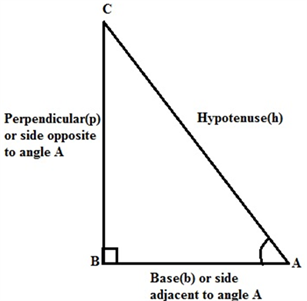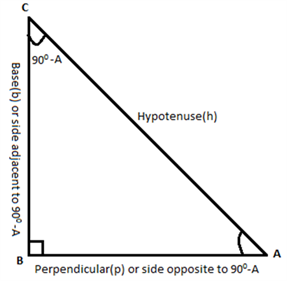Trigonometric Ratios of Complementary Angles
In Mathematics, the complementary angles are the set of two angles such that their sum is equal to 90°. For example, 30° and 60° are complementary to each other as their sum is equal to 90°. In this article, let us discuss in detail about the complementary angles and the trigonometric ratios of complementary angles with examples in a detailed way.
Complementary Angles Definition
The two angles, say ∠X and ∠Y are complementary if,
∠X + ∠Y = 90°
In such a condition ∠X is known as the complement of ∠Y and vice-versa.
In a right angle triangle, as the measure of the right angle is fixed, the remaining two angles always form the complementary as the sum of angles in a triangle is equal to 180°.
Finding Trigonometric Ratios of Complementary Angles
Assume a triangle ∆ABC, which is right-angled at B.

∠A and ∠C form a complementary pair.
⇒ ∠A + ∠C = 90°
The relationship between the acute angle and the lengths of sides of a right-angle triangle is expressed by trigonometric ratios. For the given right angle triangle, the trigonometric ratios of ∠A is given as follows:
sin A = BC/AC
cos A = AB/AC
tan A =BC/AB
csc A = 1/sin A = AC/BC
sec A =1/cos A = AC/AB
cot A = 1/tan A = AB/BC
The trigonometric ratio of the complement of ∠A. It means that the ∠C can be given as 90° – ∠A

As ∠C = 90°- A (A is used for convenience instead of ∠A ), and the side opposite to 90° – A is AB and the side adjacent to the angle 90°- A is BC as shown in the figure given above.
Therefore,
sin (90°- A) = AB/AC
cos (90°- A) = BC/AC
tan (90°- A) = AB/BC
csc (90°- A) =1/sin (90°- A) = AC/AB
sec (90°- A) = 1/cos (90°- A) = AC/BC
cot (90°- A) = 1/tan (90°- A) = BC/AB
Comparing the above set of ratios with the ratios mentioned earlier, it can be seen that;
sin (90°- A) = cos A ; cos (90°- A) = sin A
tan (90°- A) = cot A; cot (90°- A) = tan A
sec (90°- A) = csc A; csc (90°- A) = sec A
These relations are valid for all the values of A that lies between 0° and 90°.
Summary:
- Sin of an angle = Cos of its complementary angle
- Cos of an angle = Sin of its complementary angle
- Tan of an angle = Cot of its complementary angle
Trigonometric Ratios of Complementary Angles Examples
To have a better insight on trigonometric ratios of complementary angles consider the following example.
Example:
If A, B and C are the interior angles of a right-angle triangle, right-angled at B then find the value of A, given that tan 2A = cot(A – 30°) and 2A is an acute angle.
Solution:
Using the trigonometric ratio of complementary angles,
cot (90°- A) = tan A
From this ratio, we can write the above expression as:
⇒ tan 2A = cot (90°- 2A) ….(1)
Given expression is tan 2A = cot (A – 30°) …(2)
Now, equate the equation (1) and (2), we get
cot (90°- 2A) = cot (A – 30°)
⇒ 90°- 2A = A – 30°
⇒3A = 90° + 30°
⇒3A = 120°
⇒A = 120°/ 3
⇒ A = 40°
Thus, the measure of the acute angle A can be easily calculated by making use of trigonometry ratio of complementary angles.
Video Lesson
Trigonometric Ratios of Compound Angles

To know more about trigonometric ratios of complementary angles and its applications, download BYJU’S – The Learning App.